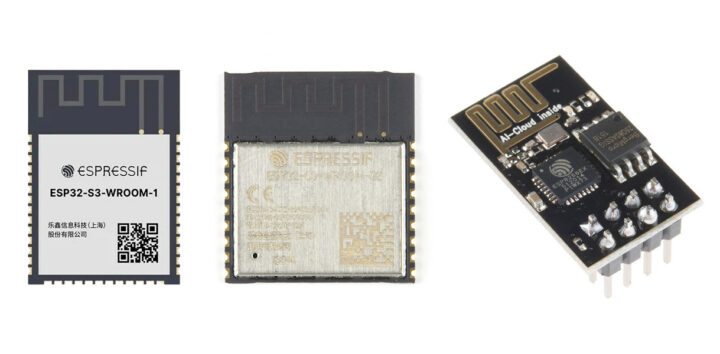The ESP32-S3 chip is equipped with an Xtensa 32-bit LX7 dual-core processor clocked at up to 240 MHz, supports 2.4 GHz Wi-Fi and Bluetooth 5 LE, and boasts AI instructions, as well as a reliable security encryption engine, specially built for the AIoT market.
Modules based on the ESP32-S3 processor bring many benefits to designers with support for Bluetooth Long Range mode, plenty of resources with 512 KB SRAM (TCM), 45 programmable GPIO pins, and rich communication interfaces. They can also handle high-speed Octal SPI flash with higher capacities, as well as off-chip PSRAM.
 So, what are the differences between the new ESP32-S3 modules, and typical ESP32-C3 and ESP8266 modules? Let’s find out.
So, what are the differences between the new ESP32-S3 modules, and typical ESP32-C3 and ESP8266 modules? Let’s find out.
| Module's CPU | ESP32-S3 | ESP8266 | ESP32-C3 |
|---|---|---|---|
| Frequency Range | 2400~2483.5MHz |
||
| Operating Temperature | -40~85°C |
||
| Storage Temperature | -40~125°C, <90%RH |
||
| Power supply range | 3.0V - 3.6V, 500mA+ |
||
| Supported Interfaces | UART, GPIO, ADC, PWM, I2C, I2S, SPI, LCD, DVP, RMT, SDIO, USB OTG, MCPWM DMA, TWAI | UART, GPIO, ADC, PWM, SPI, I2C |
|
| Number of IOs | 38 | 9 | 22 |
| Typical PSRAM | 64 MBit | - |
|
| Typical SPI flash | 64 Mbit | 16Mbit/32Mbit |
|
| CPU | Dual-core Xtensa LX7 @ up to 240 MHz with additional vector instructions for AI acceleration ULP core to handle low power modes | Single-core Xtensa L106 32-bit RISC microprocessor @ 160 MHz | Single 32-bit RISC-V (RV32IMC) core @ 160 MHz |
| On-chip RAM | 512KB | 160KB | 400KB |
| On-chip ROM | 384KB | N/A |
|
| WiFi | WiFi 4 (802.11n) |
||
| Bluetooth | BLE 5.0 | N/A | BLE 5.0 |
| Power Consumption | |||
| Modem sleep | 20mA | 15mA |
|
| Light sleep | 240μA | 2mA | 130μA |
| Deep sleep | 8μA | 20μA | 5μA |
| Hibernation | 7μA | - |
|
| Power off | 1μA | 0.5μA | 1μA |

Jean-Luc started CNX Software in 2010 as a part-time endeavor, before quitting his job as a software engineering manager, and starting to write daily news, and reviews full time later in 2011.
Support CNX Software! Donate via cryptocurrencies, become a Patron on Patreon, or purchase goods on Amazon or Aliexpress




